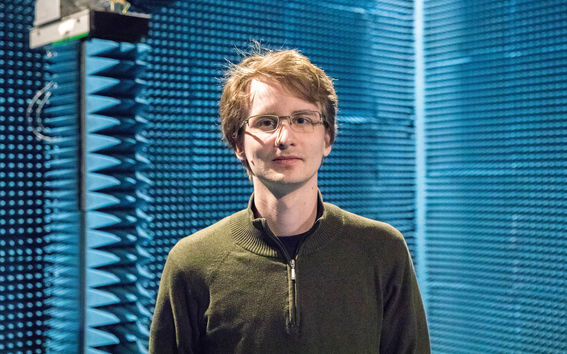A doctoral student's dream: A joint doctoral thesis concept by Aalto and Saab

'What is always most rewarding is when we build a prototype and get to make measurements. We have good research facilities. The new anechoic chamber is a good place to conduct measurements.'
Henri Kähkönen started his doctoral thesis study last autumn through the Industrial PhD concept of Aalto and Saab, which is funded by Saab. He feels that he is able to combine the good sides of working with a company and a university. 'If I did all of my thesis work in the company I would have less time for research. But if I worked only at the university I would have time for research, but my connections with the corporate world would not be as good. Now I am able to concentrate on research 100 percent, but at the same time the cooperation with the company is very close.'
Henri is also pleased that having a fixed employment contract means that there is security and a future plan for his life.
'I work mainly at Aalto, but I regularly visit and hold meetings with representatives of Saab. At monthly meetings we report on the progress of our research and we get good comments on what would be a good way forward. At the same time, we get information on how the results will benefit the company', Henri says. In the spring Henri will spend a month at Saab in Gothenburg to work in a product development project. This operating model is important, as it ensures that information from the research can be passed on to product development, and researchers will see what kinds of challenges there are in the development of existing products.
Radars as topics of research
For his dissertation Henri is studying antennas operating in the 26-40 GHz range. 'Antennas in this band have been studied before, but few studies have been published on phased array antenna groups, which operate on the full width of the band in question. A phased array antenna group is a group formed of several antennas whose antenna elements are about half a wavelength from each other in order to achieve good performance. In the future antennas could be built on this band because the higher the frequency, the sharper the radar image. However, there is the drawback, that the radar will not see objects that are far away.'
What is the work of a researcher like? In Henri's case he is first looking at the background material - on what has been studied before on the subject. The aim is naturally to develop better solutions than what the previous ones have been. 'We make many simulations from which we can see if we have succeeded in getting it to function better. After that we will think about how we might manufacture the solution that we have developed either out of metal or pieces of plastic. Finally, we manufacture a prototype that we test in an anechoic chamber.' Another result of the research is getting experience of new methods of manufacturing antennas, such as new methods for 3D printing with metal.
The production of a prototype is the final step in ensuring that the solution that was developed will also work in real life. Saab's technical experts are involved in the steering group of Henri's project. The aim of this is to ensure that Saab can quickly make use of successful results.
Aalto and Saab have a cooperation agreement
Saab's head of research Petteri Alinikula says that a similar practice is quite common in Sweden.
'In Swedish companies experienced experts might go to university to improve their skills and knowledge, share know-how, and expand their networks', he says. Aalto University and SAAB signed a ten-year cooperation agreement slightly over a year ago.
'We are constantly looking for masters of science in technology in Finland for the Aalto and Saab industrial doctorate programme who are interested in cooperating in research.'
Read more about the Aalto and Saab cooperation agreement >>
More information about the programme:
Mirella Lähteenmäki
Head of Corporate Relations
mirella.lahteenmaki@aalto.fi
+358 40 3538341






